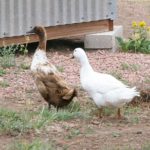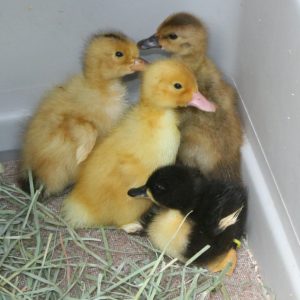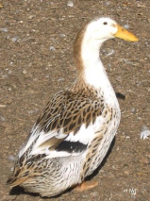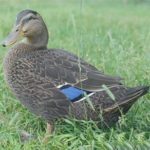
The six ducks we’ve raised since August 2016 had dwindled down to two good layers, so we recently decided to get a flock of new ducklings to start raising while the two were still laying. As we awaited the arrival of the ducklings and began to raise them in the brooder, the two remaining layers became quite crabby and no fun to have around—perhaps they missed their friends or didn’t like being a flock of two. Since we had the new ducklings growing fast in the brooder, we decided to cull the remaining adults and start over. We just didn’t want the kids to learn bad habits from the big ducks (quacking uncontrollably whenever we walk near). Hopefully this new crew will be happier, quieter, and more friendly. We will work on that from the start!
We originally ordered four ducklings online from Metzer Farms. Metzer Farms now accommodates folks like us who only want a small number of ducklings. There is an extra fee for shipping small orders, but since we really don’t want 10 ducklings, we were willing to pay the extra shipping. We were able to get them sexed, and ordered females only.
 Sadly, one of our baby ducklings didn’t make it through the first night at home. She was scrawny right out of the box, and not as active as the others. We had doubts she’d make it. Fortunately, Metzer Farms offers either a refund or replacement when ducklings do not survive the trip. They are unable to safely ship just one duckling, so she needed a companion duckling. They offer to send a “mystery” duckling free of charge, or one of our choice that we pay for. We chose a female of another breed we were interested in. They hatched just one week after the first 3, and we received them last week. Now we have 5 baby ducklings, growing fast in our care.
Sadly, one of our baby ducklings didn’t make it through the first night at home. She was scrawny right out of the box, and not as active as the others. We had doubts she’d make it. Fortunately, Metzer Farms offers either a refund or replacement when ducklings do not survive the trip. They are unable to safely ship just one duckling, so she needed a companion duckling. They offer to send a “mystery” duckling free of charge, or one of our choice that we pay for. We chose a female of another breed we were interested in. They hatched just one week after the first 3, and we received them last week. Now we have 5 baby ducklings, growing fast in our care.
Metzer Farms’ website provides a nice comparison table of the duck breeds they sell, so we made our decision based on these observations. Our criteria for choosing duck breeds are:
- We want ducks that will lay the most eggs.
- We prefer calmer ducks that don’t quack too much.
- We want ducks that will forage and find their own food. We have 40 acres for them to explore, although they don’t go any farther than 1 or 2.
- Different colors. We want to be able to tell them apart at a glance. And Laurie likes pretty ducks.
We have chosen these five:
 White Layer. One of the ducks we currently have is a white layer from Metzer Farms. She has been our most consistent layer and has a calm demeanor, even though she rates 6.7 on the temperament scale. (10 is high) She forages right along with the rest of the ducks, rated “Good” for foraging, and her all-white feathers make her easy to spot.
White Layer. One of the ducks we currently have is a white layer from Metzer Farms. She has been our most consistent layer and has a calm demeanor, even though she rates 6.7 on the temperament scale. (10 is high) She forages right along with the rest of the ducks, rated “Good” for foraging, and her all-white feathers make her easy to spot.
 Golden 300 Hybrid Layer. Also bred at Metzer Farms, this duck promises to lay 200-290 eggs per year. She rates high on the temperament scale at 7.7, but we hope that the other calmer ducks will keep her in check. She should also be a “Good” forager, and will be a brownish color.
Golden 300 Hybrid Layer. Also bred at Metzer Farms, this duck promises to lay 200-290 eggs per year. She rates high on the temperament scale at 7.7, but we hope that the other calmer ducks will keep her in check. She should also be a “Good” forager, and will be a brownish color.
 Silver Appleyard. This breed rates 1.2 for the calmest temperament, and “Very Good” at foraging. She won’t lay as many eggs, 120-175 per year, but hopefully her calm demeanor and foraging will encourage the others to follow suit. She will have mixed colors of white and brown.
Silver Appleyard. This breed rates 1.2 for the calmest temperament, and “Very Good” at foraging. She won’t lay as many eggs, 120-175 per year, but hopefully her calm demeanor and foraging will encourage the others to follow suit. She will have mixed colors of white and brown.
 Black Swedish. This should also be a calm duck, 2.3 on the scale. She should lay 130-180 eggs per year and be a “Good” forager. She will be predominantly black with a white chest. This is the one that didn’t survive, and we will receive a replacement next week.
Black Swedish. This should also be a calm duck, 2.3 on the scale. She should lay 130-180 eggs per year and be a “Good” forager. She will be predominantly black with a white chest. This is the one that didn’t survive, and we will receive a replacement next week.
 Rouen. These ducks are known to be on the calm side, a 4.5 on the temperament scale. She should lay 140-180 eggs per year and should be a good forager. She may lay blue-green eggs, and should be a nice looking, dark brown duck.
Rouen. These ducks are known to be on the calm side, a 4.5 on the temperament scale. She should lay 140-180 eggs per year and should be a good forager. She may lay blue-green eggs, and should be a nice looking, dark brown duck.
This will be our fourth time to raise ducklings. We hope to pay more attention to their care than we have for the past couple of flocks, and keep better track of things like lighting schedules to promote better egg production. We also intend to pick them up and hold them more often, particularly right at first, which may keep them a bit more friendly and calm. At this point (two weeks in) we have a happy little brood of ducklings!
